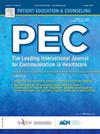“一切看起来都让人放心。”管理急诊室出院过程中的不确定性。
IF 3.1
2区 医学
Q2 PUBLIC, ENVIRONMENTAL & OCCUPATIONAL HEALTH
引用次数: 0
摘要
目的:诊断不确定性在急诊科(ED)普遍存在。我们研究了在急诊科出院过程中,临床医生(医生、医师助理、执业护士和护士)与成年患者之间自然发生的互动中,不确定性是如何传达的。方法:对40例18岁及以上成年患者出院过程中的谈话进行录音。每个患者参与者都记录了与注册护士的互动,15名患者还记录了与HCP(定义为医生、医师助理或执业护士)的互动。共有10名HCPs,包括6名医生、3名医师助理和1名执业护士。我们使用谈话分析(一种定性方法)来探讨在出院谈话中如何传达不确定性。结果:HCPs使用诊断测试结果、专家建议和他们自己的评估作为他们决定将患者从急诊科出院的证据来源。HCPs检查患者以确认患者是否符合出院计划和门诊随访或验证治疗的有效性。结论:尽管不确定,急诊HCPs还是决定让患者出院回家。他们为患者提供证据,证明检查是彻底的,最危险的情况已经排除,他们可以安全出院,门诊随访。实践启示:我们的研究表明,在急诊科的高风险环境中,hcp确实传达了不确定性。尽管存在不确定性,但医护人员表明他们有责任向患者证明他们可以安全回家。与病人一起检查可能是评估他们安全感的一种方式,但进一步的研究是必要的。本文章由计算机程序翻译,如有差异,请以英文原文为准。
“Everything looks reassuring.”: Managing uncertainty during the emergency department discharge process
Objective
Diagnostic uncertainty is prevalent in the emergency department (ED) setting. We examined how uncertainty was communicated during naturally occurring interactions between clinicians (physicians, physician assistants, nurse practitioners, and nurses) and adult patients during the ED discharge process.
Methods
We audio-recorded conversations during the discharge process of 40 adult patients (age 18 and older). Each patient participant had an interaction with an RN recorded and 15 also had an interaction with an HCP (defined as physician, physician assistant or nurse practitioner) recorded. There were 10 HCPs, including six physicians, three physician assistants, and one nurse practitioner. We used conversation analysis, a qualitative method, to explore how uncertainty is communicated during discharge conversations.
Results
HCPs use results of diagnostic testing, expert recommendation, and their own assessment as sources of evidence for their decision to discharge patients from the ED. HCPs check in with patients to confirm patient alignment with the plan for discharge and outpatient follow-up or to verify the usefulness of treatment.
Conclusions
Emergency HCPs account for their decision to discharge patients home from the ED despite uncertainty. They provide patients with evidence that the workup was thorough, the most dangerous conditions have been ruled out, and they are safe to be discharged with outpatient follow-up.
Practice Implications
Our study showed that in the high-stakes environment of the ED, HCPs do communicate uncertainty. Despite the uncertainty, HCPs showed they were accountable to patients to demonstrate they were safe to go home. Checking in with the patient might be a way to assess their feelings of safety but further study is necessary.
求助全文
通过发布文献求助,成功后即可免费获取论文全文。
去求助
来源期刊

Patient Education and Counseling
医学-公共卫生、环境卫生与职业卫生
CiteScore
5.60
自引率
11.40%
发文量
384
审稿时长
46 days
期刊介绍:
Patient Education and Counseling is an interdisciplinary, international journal for patient education and health promotion researchers, managers and clinicians. The journal seeks to explore and elucidate the educational, counseling and communication models in health care. Its aim is to provide a forum for fundamental as well as applied research, and to promote the study of organizational issues involved with the delivery of patient education, counseling, health promotion services and training models in improving communication between providers and patients.
 求助内容:
求助内容: 应助结果提醒方式:
应助结果提醒方式:


